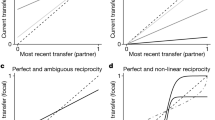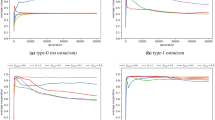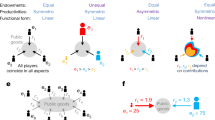Abstract
Roberts and Sherratt argue that if agents with identical tags are allowed a choice of behaviour, then tag similarity can no longer be a reliable guide to behaviour and so similarity does not breed cooperation. Although they are correct in noting that in our model1 an agent will always donate when it meets another with an identical tag, we do not believe that their basic claim is correct.
Similar content being viewed by others
Riolo et al. reply
We have replicated the results of Roberts and Sherratt and have run a generalized model that includes theirs as one extreme and our original model as another (details are available from R.L.R.). We find that if mutations are not biased as strongly towards 'never donate', as in their version of the model, similarity can indeed breed cooperation. Whether it does, and to what extent, depends on several factors, including the rate at which 'never donate' agents are created, the number of pairings, the cost/benefit ratio of donations and the particular adaptive mechanisms in the model. If unconditional defection is introduced by adding a binary trait that controls whether agents never donate, or donate using tags and tolerance, we find that cooperation also emerges, but again the extent of cooperation depends on many factors.
We believe that the difference has not been fully understood between the stability of cooperation within any particular tag group and the rate of cooperation across a population consisting of diverse tags with changing frequencies over time. There is no dispute that particular cooperative tag groups are invadable1,2. However, as one tag group is invaded and thus dies off, another tag group with more reliable cooperators can flourish and become dominant, resulting in the cycles of cooperation and tag dominance noted previously1,3.
Roberts and Sherratt claim that cooperation based on similarity was built into our model. It was not, which is why, under some parameter settings (few pairings or high cost of donation), cooperative periods are rare and short-lived, resulting in very low overall donation rates1. Nevertheless, the level of cooperation for other parameter settings is substantial, with the overall rate of cooperation depending on the relative dynamics of invasion, resistance and emergence of dominant groups.
Many factors could affect the dynamics generated by tag-based mechanisms. For instance, tags that are easy to copy might lead to high rates of invasion, whereas other tags, such as language or accent, might be difficult to copy3. Our model could also be extended to study how a tag mechanism acts in conjunction with other mechanisms known to affect the emergence of cooperation. For example, territorial distribution of agents might favour 'speciation' into self-enforcing stereotypes3. Further investigation is needed to understand fully the range of mechanisms that can produce cooperation without reciprocity. Our results show that, under some conditions, tag mechanisms are one viable approach.
References
Riolo, R. L., Cohen, M. D. & Axelrod, R. Nature 414, 441–443 (2001).
Robson, A. J. J. Theor. Biol. 144, 379–396 (1990).
Sigmund, K. & Nowak, M. A. Nature 414, 403–405 (2001).
Author information
Authors and Affiliations
Corresponding author
Rights and permissions
About this article
Cite this article
Riolo, R., Cohen, M. & Axelrod, R. Does similarity breed cooperation?. Nature 418, 500 (2002). https://doi.org/10.1038/418500a
Issue Date:
DOI: https://doi.org/10.1038/418500a
Comments
By submitting a comment you agree to abide by our Terms and Community Guidelines. If you find something abusive or that does not comply with our terms or guidelines please flag it as inappropriate.



